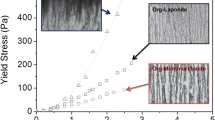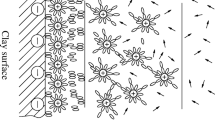Abstract
The particle level responses to different external loadings of a montmorillonitic clay soil are investigated numerically. The soil is saturated by a solution of monovalent counterions, of varying concentrations. We use finite element micromechanical models (based on the Poisson-Nernst-Planck equations) to estimate counterion and electrical potential distributions around individual clay particles at various distances from one another, since analytical solutions are not possible for these complex arrangements of particles. Disjoining pressures are then estimated using the Van’t Hoff relation and Maxwell stress tensor. As the distance between the clay particles decreases and double-layers overlap, the concentration of counterions in the micropores between clay particles increases. This increase lowers the chemical potential of the pore fluid and creates a chemical potential gradient in the solvent that generates the so-called “disjoining” or “osmotic” pressure. Because of this disjoining pressure, it is clear that particles need not contact one another in order to carry an “effective stress”. This work may lead towards theoretical predictions of the macroscopic load deformation response of montmorillonitic soils based on micro-electro-chemo-mechanical modelling of particles.
Similar content being viewed by others
References
Anandarajah, A. and Chen, J. (1994). “Double-layer repulsive force between two inclined platy particles according to the Gouy-Chapman theory.” Journal of Colloid and Interface Science, Vol. 168, No. 1, pp. 111–117.
Anandarajah, A. and Lu, N. (1991). “Numerical study of the electrical double-layer repulsion between non-parallel clay particles of finite length.” International Journal for Numerical and Analytical Methods in Geomechanics, Vol. 15, No. 10, pp. 683–703.
Bolt, G. H. (1956). “Physico-chemical analysis of the compressibility of pure clays.“ Geotechnique, Vol. 6, No. 2, pp. 86–93.
Cho, G.-C., Dodds, J., and Santamarina, J. C. (2006). “Particle shape effects on packing density, stiffness, and strength: Natural and crushed sands.” Journal of Geotechnical and Geoenvironmental Engineering, Vol. 132, No. 5, pp. 591–602.
COMSOL-AB. (2007). Comsol multiphysics user’s guide, Stockholm.
Cussler, E. L. (1997). Diffusion mass transfer in fluid systems, Cambridge University Press, New York, USA.
Grodzinsky, A. (2000). Fields, forces and flows in biological systems, Massachusetts Institute of Technology, p. 430.
Jackson, J. D. (1998). Classical electrodynamics, Wiley, New York.
Mitchell, J. K. and Soga, K. I. (2005). Fundamentals of soil behavior, John Wiley & Sons, Hoboken, N.J.
Murad, M. A. and Moyne, C. (2002). “Micromechanical computational modeling of expansive porous media.” C. R. Mecanique, Vol. 330, No. 12, pp. 865–870.
Phillips, R. J. (1999). “Electrostatic forces between particles and planar interfaces.” Interfacial Forces and Fields: Theory and Applications, Surfactant Science Series, Hsu, J.-P. ed., Dekker, M., New York, Vol. 85, pp. 251–288.
Santamarina, J. C., Fam, M. A., and Klein, K. A. (2001). Soils and waves, Wiley, Chichester.
Shrindharan, A. (2002). “Engineering behaviour of clays: Influence of mineralolgy.” Chemo-Mechanical Couplings in Clays: From Nanoscale to Engineering Applications, Balkema, A. A., pp. 3–28.
Smith, D., Pivonka, P., Jungnickel, C., and Fityus, S. (2004). “Theoretical analysis of anion exclusion and diffusive transport through platy-clay soils.” Transport in Porous Media, Vol. 57, No. 3, pp. 251–277.
Sposito, G. (1984). The surface chemistry of soils, Oxford University Press, New York, p. 234.
Stratton, J. A. (1941). Electromagnetic theory, McGraw-Hill, New York.
Terzaghi, K. (1943). Theoretical soil mechanics, Wiley, New York.
Van Olphen, H. (1977). An introduction to clay colloid chemistry, for clay technologists, geologists, and soil scientists, John Wiley and Sons, New York.
Verwey, E. J. W., Overbeek, J. T. G., and Nes, K. V. (1948). Theory of the stability of lyophobic colloids: The interaction of soil particles having an electric double layer, Elsevier Pub. Co., New York.
Author information
Authors and Affiliations
Corresponding author
Rights and permissions
About this article
Cite this article
Smith, D.W., Narsilio, G.A. & Pivonka, P. Numerical particle-scale study of swelling pressure in clays. KSCE J Civ Eng 13, 273–279 (2009). https://doi.org/10.1007/s12205-009-0273-7
Received:
Revised:
Accepted:
Published:
Issue Date:
DOI: https://doi.org/10.1007/s12205-009-0273-7




